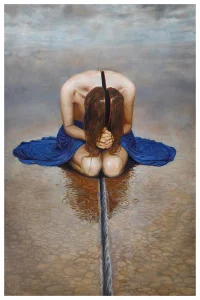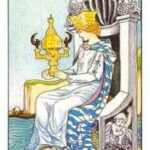[T]he individual who wishes to have an answer to the problem of evil, as it is posed today, has need, first and foremost of self-knowledge, that is, the utmost possible knowledge of his own wholeness. He must know relentlessly how much good he can do, and what crimes he is capable of, and must beware of regarding the one as real and the other as illusion. Both are elements within his nature, and both are bound to come to light in him, should he wish—as he ought—to live without self-deception and self-delusion. C.G.Jung, Memories, Dreams, Reflections (1962), p. 330.
Of all the obstacles to spiritual maturity, dualistic thinking about God’s moral code is perhaps the most difficult to deal with and the most dangerous to humanity. For many seekers, the classic conflict between good and evil is the name of the religious game, and everything—including human life and the fate of our planet—depends on who wins. If my God has a different conception of right and wrong than yours, then the hell with you! You deserve to have your brains blown out.
Am I right? in this way of thinking, the highest priority isn’t to live and act with compassion but to have correct beliefs. Right there you know you’re talking about Epoch II because you’re all about mental abstractions and either/or judgments.
Unlike the majority of their peers, the men who founded the great patriarchal religions had evolved beyond Epoch I. Ever since Eve ate the apple, there have been serious seekers who consider heady issues like what is right and what is wrong, what is God and what is evil. The founding patriarchs had developed healthy egos and acquired consciences. And because they were trying to hard to be the good guys, they reasoned that evil must exist out there in the dark world of otherness. It couldn’t be in them.
Based on their growing self-reflective awareness and the dualistic thinking it spawned, they chose what they considered to be the good in every pair of opposites and formed their God-images around these words, qualities, and concepts. This kind of thinking was necessary if humanity was to become more conscious and morally responsible. But they misused it when they assigned the label of evil to the rejected opposite. This tendency of every Epoch II ego is the reason for Jesus’s notable and widely ignored suggestion [Matthew 7:4, 5 and Luke 6:41, 42] to look not for the mote in thy neighbor’s eye but for the log in thine own.
For example, instead of seeing the Great Mother as an opposite and complementary aspect of Creation, they portrayed her as a threat to growing consciousness. To them, Goddess represented their former Epoch I condition of instinctual behavior and moral irresponsibility, whereas the new solitary masculine God symbolized their hope of evolving toward a “higher,” more perfected and enlightened consciousness. Terrified of losing the ground they had worked hard to gain, many of them believed they had to destroy Goddess’s worship and replace it with their new bias toward God. And since they feared their own feminine sides, they demonized Goddess. This is why femininity is still associated with the unconscious and, for some people, dangerous and evil aspects of the psyche.
For the past five thousand years, Goddess has been the overarching symbol for what patriarchal religions of the West and Middle East have rejected. She is the whore male authorities have projected onto every defenseless woman who has been stripped of her autonomy, used for their purposes, and then abandoned to fend for herself. She is the witch they tortured and torched for stirring their terror of feminine power. She is the devil who tempts us to sin, the seductress who infiltrates our fortresses and weakens our resolve, the heretic who threatens to expose the pathology of our pat beliefs, the nemesis of every pious do-gooder who acts from the head and not the heart.
But before she was a symbol of evil, she represented something very good indeed: loving and creative partnership between the two complementary energies of life. By demonizing her we subverted our hopes for wholeness. By integrating her we can break out of the dualistic prison that bars our growth.
It is, however, true that much of the evil in the world comes from the fact that man in general is hopelessly unconscious, as it is also true that with increasing insight we can combat this evil at its source in ourselves, in the same way that science enables us to deal effectively with injuries inflicted from without. “The Spiritual Problem of Modern Man” (1928/1931), CW 10, par. 166.
This material is taken from Healing the Sacred Divide.
Art Image: Dualism, by Miles Johnston
Jean Raffa’s The Bridge to Wholeness and Dream Theatres of the Soul are at Amazon. Healing the Sacred Divide can be found at Amazon and Larson Publications, Inc. Jean’s new Nautilus Award-winning The Soul’s Twins, is at Amazon and Schiffer’s Red Feather Mind, Body, Spirit. Subscribe to her newsletter at www.jeanbenedictraffa.com.





8 Responses
Thank you for this quite incredible material Jeanie opening up not only so much of history – but also revealing so much about the ‘self.’ For some reason images of stone sculptures and memorials are flitting around my brain while reading this. Maybe stone, or the understanding of stone we have now, represents one polarity. Yesterday I felt my ‘heart of stone’ while passing by the damaged woman who sits outside the dollar store. Previously I’ve given her dollar store gift cards but yesterday the judgement in me saw her as ‘wrong’ (such demands on me!) thus justifying my heart of stone. I can expand that anecdote to include the (much more significant) historical scenarios you discuss. I can only imagine what she is capable of, what she perhaps even symbolizes, and what cut her down in her youth. I hope I’m on the right track here in understanding your writing.
Hi Steven, I think you are on the right track. Soft is associated with the feminine principle, and hard with the masculine. A heart of stone is a hard heart; one that doesn’t want to feel and so shuts down its compassion. Perhaps as a way of protecting ourselves from feeling our own pain, maybe from having been taken advantage of, or wounded or betrayed by people we have loved, especially in our youth. Like Scrooge: the poster boy for hard heartedness! Or because it feels like others are taking advantage of us, or making too many demands on us. We all feel that way sometimes.
I think it’s very cool that you are aware of your images and emotions and can see them objectively enough to reflect on them. And yes, you do understand my writing. I write about things like this to inspire others to do exactly what you’re doing. Thank you for sharing your reflections here. 🙂
Hi, my dear Jeane. It is indeed a great catch! I mean, it is an essential issue of all of our “not only” social problems but also finding the answer to our existence. We might be happy that Eve has bitten the apple! Although it caused great pain to women for many centuries. I think the goal is to accept the good and evil in us; in the old Persian religion, Zarathustrians believed in two Gods: the good one, Ahuramazda and the bad one, Ahriman. Even when we search further, we see Mani, the prophet (or the painter) who followed dualism with more spirituality to separate the two Gods from each other, like the Cathars. Thank you, as always, for this excellent lesson. Stay safe and well.
Hi, Aladin. Yes, I agree. The goal is to accept the good and evil in ourselves. I didn’t know the Zoroastrians believed in two Gods. Knowing next to nothing about Iranian religions, I had to look up Mani, the prophet of Manichaeism. I find it so interesting that this religion also dealt with the struggle between a good, spiritual world of light, and an evil, material world of darkness.
To me, this phenomenon suggests an evolutionary stage of development in the ego as it awakens to two ways of perceiving— represented by the “masculine” drive for self-preservation, associated with the brain’s left hemisphere, and the “feminine” drive for species-preservation which is associated with the brain’s right hemisphere—and mistakenly projects all pairs of opposites onto males and females. Whereas Buddhism is about awakening to the realization that all of these things exist in us and can be united into a state of enlightened wholeness, or nirvana.
So essentially, religion and spiritual striving are all about humanity’s striving for psychological and spiritual wholeness. I guess that’s why I resonate so much with Jungian psychology, which has the same goal, sans the trappings of dualistic patriarchal religions!
Thanks for your always inspiring comments. You always get me to thinking and doing more research!! Be well, my friend. Jeanie
I salute to your inner warrior and your mission for psychological truth and intelligence.
Even as a child I thought there was something simple-minded about the interpretation of Eve’s action in the garden of Eden. The myth’s significance accrued over the years. Without Eve’s desire to taste the apple, consciousness could not have happened. We either slumber in the womb, or we emerge into life and wake to the task of understanding that … Reality is a function of Contradiction … as my Sufi mentor used to say. Despite all the horrible things that happen in the world, individual consciousness is expanding, raising the collective awareness of the underlying wholeness of the universe.
Thanks for your opening tribute. I send you the same valuation.
Reality is a function of Contradiction. I like this. If we can accept it, we can accept that life is about both/and, not either/or. And if we can accept that, we can accept that the inner world is as real and valuable as the outer world. And if we can accept that, we can accept that our goal is to expand into our whole selves by fully engaging in, and dialoguing with, and uniting both. 🙂
Thanks Jeanie, reading this only now, and a few more to go. I love these wise truths and their historical expansion.
Thanks for reading, Susan. I hope you enjoy the next ones.